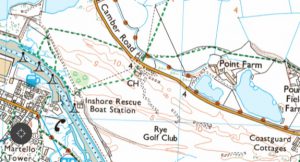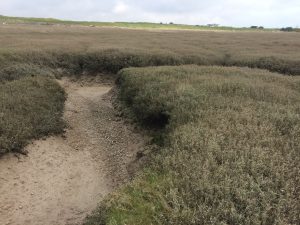Following on from Rye News’ recent article, on the fact that Natural England’s Coast Path will be bypassing Rye, at a recent Rye Town Council meeting Councillor Chris Hoggart spoke up on the importance of continuing the coast path through Rye. The coast path will form a national trail around the country and he believes it will attract walkers and ramblers to Rye that would in turn support local businesses.
Councillor Hoggart stressed that Rye is in a unique position because it is where five long distance trails and paths (see below) converge and he is drafting a response to Natural England on behalf of the town council in support of continuing the path through Rye.
In a recent conversation with Rye News, Councillor Hoggart expressed surprise that the coast path was avoiding Rye altogether. Until recently he had worked at Natural England and had presented to the town council and told them that the path would be passing through Rye. Since then Natural England has reneged on this decision and he explained that it is rare for this nationally significant path to have such a break in its route.
Promoting Rye to walkers and ramblers is listed as an aspiration in the recently agreed Rye Neighbourhood Plan under its ‘Green Tourism’ strand. This is in recognition that from Rye you can access an abundance of walks through beautiful open countryside and easy access to the coast. In addition, Rye is, in turn, easily accessible by public transport.
There are two main obstacles blocking the coast path’s way through Rye:
1) Rye Golf Club and the ESCC missing path
Walkers along the river Rother to Camber Sands have recently noticed a number of new additions. Rye Golf Club have installed people counters to measure the number of people walking on the old Tramway path that leads to the Harbour Master’s building and onward to Camber Sands. Following a Rye News enquiry, Rye Golf Club said, “There is a strong likelihood that any such imposing of the pathway across our golf course would result in a significant increase in footfall which in turn could seriously impact the ability to retain a number of golf holes because of health and safety. We continue to reserve the right to review the use of the permissive path.”

In their consultation document Natural England had claimed Rye Golf Club were opposed to the coast path running along the old Tramway path because they felt it would encourage more walkers alongside the golf course and in turn disturb the golfers. In a response to Rye News the golf club said, “We are reviewing our option to rebut a suggestion from England Coastal Pathway (ECP) and Natural England to install a coastal pathway through and across the golf course and our land.”
Following a site visit to the golf course, and after studying Ordnance Survey (OS) maps, it is curious that there are already two rights of way that go right across the golf course (see map below) but the Tramway path, used most by walkers, is not one of them and is classed as a ‘permissive pathway.’
Paths marked rights of way give walkers the legal right to access the land. In addition to rights of way there is what are known as “permissive and licensed paths” – this gives walkers the right to follow a path at the landowners discretion, which can be revoked. Rye News has been in contact with Rye Golf Club and will publish their response in full next week, subject to their approval.
ESCC’s missing right of way path
In the event that Rye Golf Club stop walkers from using the old Tramway path, walkers will be in a peculiar position. On paper, ie on OS maps (see map), there is an public right of way that runs for 200m parallel to the Tramway path but, on investigation, there is no longer a path across the marsh land, which not only floods on a regular basis but is dissected by deep impassable gullies.

A sign at the start of this section informs walkers of the possibility of following an alternative route via the Tramway path and states ‘Licensed alternative route for use in times of flooding. Persons using this path do by licence of Rye Golf Club Ltd.’ What the notice doesn’t say is that the right of way path is impassable even at low tide so it begs the question, as the golf club’s route is the only viable option, but could be closed by the landowner, why has ESCC not looked after the original right of way to Camber Sands?

Rye News has contacted the rights of way team at ESCC to enquire how this has been allowed to happen, but at the time of publication have yet to receive a response. When we receive the response we will publish it in full.
2) Rye Harbour Road junction with the A259
The primary reason given by Natural England as to why the proposed coast path will not pass through Rye is the dangerous A259 and Harbour Road junction.
While the roads are operated by different authorities (the A259 is managed by Highways England and Harbour Road by ESCC) Rye News has contacted ESCC leader, and Rye’s representative on the council, Keith Glazier, to inquire what action ESCC is taking, in conjunction with Highways England, to make that junction safe for residents and walkers alike.
Installing traffic lights at the junction would seem to be the most preferable solution, especially as more traffic will be using the junction on the completion of the Discovery Centre at the Rye Harbour Nature Reserve. We will publish his response once it has been received.
Despite numerous assurances, policies and aspirations to promote sustainable transport, in a further twist to this story, local groups across East Sussex recently expressed outrage when ESCC diverted £5 million of public funding previously allocated to local cycling and walking schemes.
This led to local cycling and walking groups launching a petition demanding that ESCC reinstate the £5 million of walking and cycling funding, ‘in the light of local councils committing to carbon reduction targets and a shift to active travel.’
If ESCC is serious about public safety, while also encouraging more people to walk as a form of exercise, then they need to tackle the barriers that they themselves have created.

The deadline for submitting comments to Natural England has been extended in light of Covid-19. The original date to submit an objection (if you are a landowner that will be affected) or make a representation (if you are a local group or individual) was 23 April 2020. Natural England have not published their new deadline, but you can read their advice on how to submit your comments here.
If you are interested to see the rights of way in and around Rye, click here for ESCC’s map.
The five long distance paths that converge on Rye are:
• 1066 Country Walk
• High Weald Landscape Trail
• Saxon Shore Way
• Royal Military Canal Path
• Sussex Border Path
Image Credits: Kevin McCarthy , ESCC/OS .




Why the Rye harbour nature reserve building was allowed to go ahead,before safety measures were put into place at the top of the Rye harbour road is a scandal,knowing it would generate so much extra traffic, Once again Councils reneged when they said, no more large building consent, at the harbour until the junction was improved.All the money that was donated to that reserve by charities,lottery and well wishers,some of it should have been built into the project,before it was allowed to go ahead, of course we will be hearing all the excuses for their incompetence, lack of money,austerity, and its sad that some people think more of wild life, than people on this planet.
The Golf course issue for the Coastal path is surely a minor one as the most direct route for walkers and cyclists is to use the “new” path that follows the Camber road. This could be widened a little to improve access for cyclists and walkers on the short section from Camber to the crossing at Northpoint.
John Tolhurst’s point about the Discovery Centre is partly valid however most of the traffic that now goes to Rye Harbour are HGV’s. Traffic lights at the junction might help but even better would be to have lights on the bridge over the River Brede sluice which could be used as a pedestrian and cycle crossing on the west side of the bridge which is very narrow and only allows single vehicle crossing anyway. A small strip of land would need acquiring on the north side of the Rye harbour road from the A259 junction to the bridge so as to make a pavement/cycle path.
Didn’t Winston Churchill famously not say: “Golf is a good walk ruined!”?
While you are looking into the footpath issue, take a look at the golf club’s land title and superimpose it over an aerial photograph. I hope I’m proven wrong, but I have always felt that the club has incrementally encroached beyond its boundary.
p.s. I enjoy reading the RyeNews from afar (NZ). CC
For the record there is more in the Rye Neighbourhood Plan about cycling and pathways than as mentioned above. A good deal of work was completed on aspirations to enhance access by foot and cycle in and out of and across Rye to ensure that the 5 main South Coast tourust routes(recorded above) link.
With the failure of the Greenway to move forward, it is disappointing that the Coastal Path may now bypass Rye. Examples of improved access and connectivity addressed by the Plan include:
-The need to enhance the riverside access in the Rock Channel . This is being partly thwarted by obstructions maintained by developers and leaseholders (at the east and west end of the Channel) against the stipulations in planning and other agreements. Many who worked on the Plan saw access to the riverside around the Rock Channel as a potential jewel in Rye’s crown. We aspired to the sort of public water access found in places such as Faversham and Whitstable.
– At the east end of the Rock Channel we were hopeful that the separate ESCC/Rye Partnership study would point to better use of the site for improved public access and amenity.
-Neighbourhood Planners were told on several occasions that the Harbour Road junction did not need improvement as traffic figures did not justify it. What was done is the allocation of a piece of land at the west end of the former ESCC gritting depot for future safety improvements. What exactly is the ESCC plan here?
With the importance of tourism in Rye and as an enhancement of reasons to visit, there is much to play for in achieving better public access and connectivity across Rye.
For RNPSG
Why on the cycle path from the harbour to the A259 do cycles and pedestrians not have priority at all the junctions to the industrial sites. This would be a simple and cost effective way to improve safety and raise the profile of cyclists?